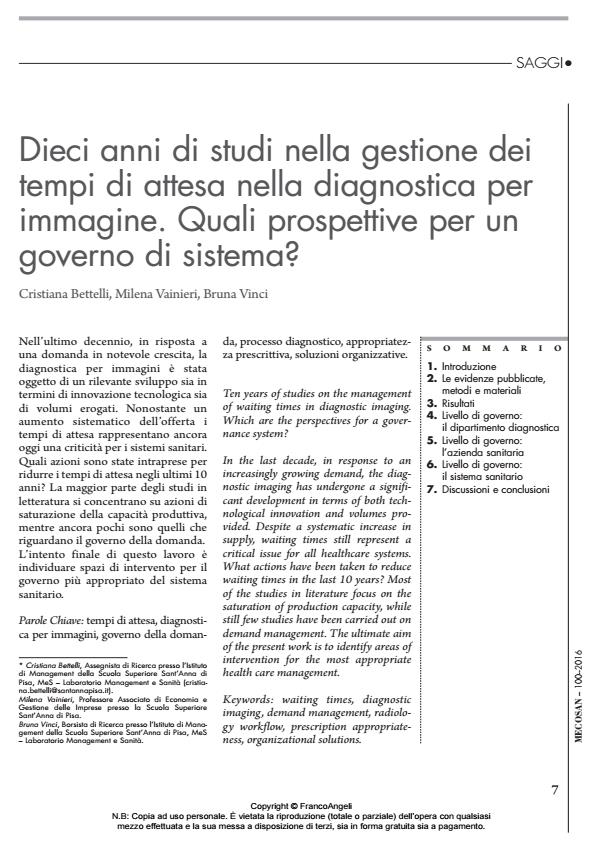Dieci anni di studi nella gestione dei tempi di attesa nella diagnostica per immagine. Quali prospettive per un governo di sistema?
Titolo Rivista MECOSAN
Autori/Curatori Cristiana Bettelli, Milena Vainieri, Bruna Vinci
Anno di pubblicazione 2017 Fascicolo 2016/100
Lingua Italiano Numero pagine 19 P. 7-25 Dimensione file 23778 KB
DOI 10.3280/MESA2016-100002
Il DOI è il codice a barre della proprietà intellettuale: per saperne di più
clicca qui
Qui sotto puoi vedere in anteprima la prima pagina di questo articolo.
Se questo articolo ti interessa, lo puoi acquistare (e scaricare in formato pdf) seguendo le facili indicazioni per acquistare il download credit. Acquista Download Credits per scaricare questo Articolo in formato PDF

FrancoAngeli è membro della Publishers International Linking Association, Inc (PILA)associazione indipendente e non profit per facilitare (attraverso i servizi tecnologici implementati da CrossRef.org) l’accesso degli studiosi ai contenuti digitali nelle pubblicazioni professionali e scientifiche
Nell’ultimo decennio, in risposta a una domanda in notevole crescita, la diagnostica per immagini è stata oggetto di un rilevante sviluppo sia in termini di innovazione tecnologica sia di volumi erogati. Nonostante un aumento sistematico dell’offerta i tempi di attesa rappresentano ancora oggi una criticità per i sistemi sanitari. Quali azioni sono state intraprese per ridurre i tempi di attesa negli ultimi 10 anni? La maggior parte degli studi in letteratura si concentrano su azioni di saturazione della capacità produttiva, mentre ancora pochi sono quelli che riguardano il governo della domanda. L’intento finale di questo lavoro è individuare spazi di intervento per il governo più appropriato del sistema sanitario.
Parole chiave:Tempi di attesa, diagnostica per immagini, governo della domanda, processo diagnostico, appropriatezza prescrittiva, soluzioni organizzative.
- Decision making tools for managing waiting times and treatment rates in elective surgery Daniel Adrian Lungu, Tommaso Grillo Ruggieri, Sabina Nuti, in BMC Health Services Research 369/2019
DOI: 10.1186/s12913-019-4199-6 - The Impact of New Surgical Techniques on Geographical Unwarranted Variation: The Case of Benign Hysterectomy Daniel Adrian Lungu, Elisa Foresi, Paolo Belardi, Sabina Nuti, Andrea Giannini, Tommaso Simoncini, in International Journal of Environmental Research and Public Health /2021 pp.6722
DOI: 10.3390/ijerph18136722 - Il ruolo della telemedicina nella gestione delle liste di attesa e nell'ampliare l'accesso a prestazioni di specialistica ambulatoriale. L'esperienza nella Regione Veneto Cecilia Menegon, Luca Del Bene, in MECOSAN 130/2025 pp.69
DOI: 10.3280/mesa2024-130oa18960 - I dati amministrativi per la governance dei tempi di attesa delle prestazioni ambulatoriali: l'esperienza dell'Azienda Sanitaria dell'Alto Adige Luca Armanaschi, Elisabetta Barzan, Magda Cavallucci, Carlo Federici, Marco Sartirana, Florian Zerzer, in MECOSAN 123/2023 pp.53
DOI: 10.3280/mesa2022-123oa15593
Cristiana Bettelli, Milena Vainieri, Bruna Vinci, Dieci anni di studi nella gestione dei tempi di attesa nella diagnostica per immagine. Quali prospettive per un governo di sistema? in "MECOSAN" 100/2016, pp 7-25, DOI: 10.3280/MESA2016-100002